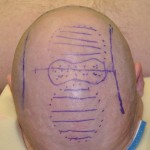Background: While the skull is often perceived as just a large round homogenous surface, it is actually made up of various regions or aesthetic units. These units arise from the various plates and suture lines from which the skull is embryologically and developmentally formed. Each of these skull areas can be prone to surface contour irregularities based on how they development and merge to form the intact skull.
One aesthetic skull region is that of the sagittal ridge or sagittal crest. This is the midline region of the skull that extends from the top of the forehead all the way to the back of the head at the bottom. Most of it does correspond to the location of the original sagittal suture seen in utero and the anterior and posterior fontanelles (soft spots) seen for a short period of time after birth. Sagittal suture line abnormalities can present as high ridges, indentations, a triangular-shaped skull and dimples or lumps over the original fontanelle areas.
Sagittal line abnormalities can become particularly apparent in men more than women due to hair issues. In men with thinning hair, are bald or who shave their head the prominence of the sagittal region of the skull becomes unmistakeable.
Case Study: This 40 year-old male was bothered by two large humps along the midline of his skull in the anteroposterior direction. There was a central dip between the two high spots. He wanted to being the high spots down to the level of the central dip or valley. In addition he had an occipital knob deformity, which is also a midline skull abnormality, although not known to be connected developmentally to the sagittal suture.


Sagittal skull reshaping can be done by bone reduction or augmentation of any low areas. Most commonly bone reduction is needed due to sutural overgrowth. Burring reduction will usually suffice as long as the thickness of bone will permit the reduction.
Highlights:
1) The sagittal line of the skull can be affected by a variety of raised or depressed areas along its midline course.
2) Sagittal ridge or sagittal crest skull contouring can be done by burring reduction and is limited by the thickness of the skull bone.
3) Aesthetic sagittal skull contouring requires small incisions to limit visible scarring.
Dr. Barry Eppley
Indianapolis, Indiana



